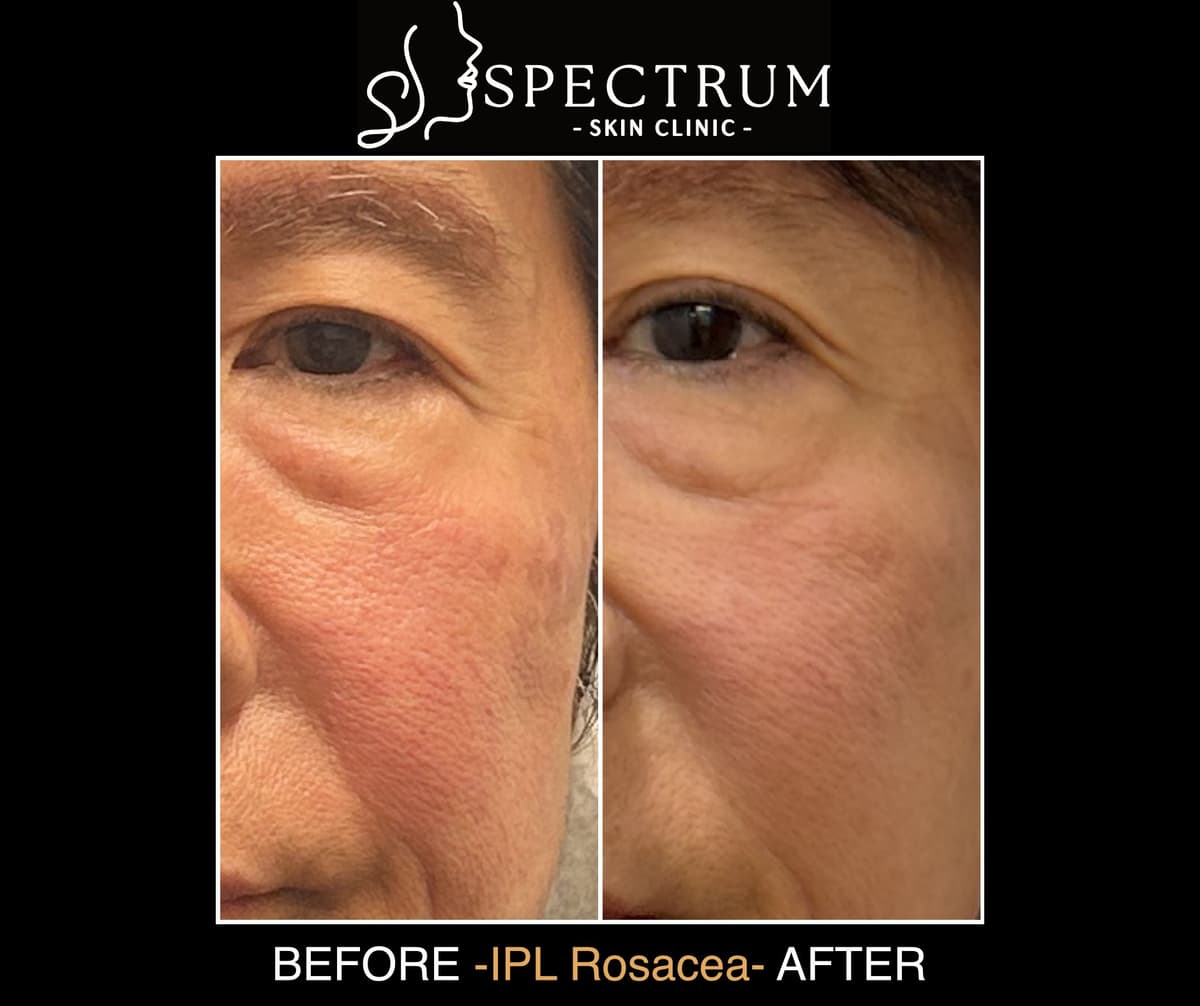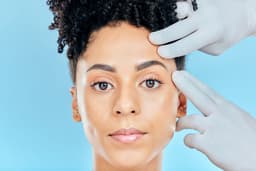IPL for Rosacea Treatment
IPL for Rosacea: Reducing Redness and Visible Blood Vessels
Rosacea is one of the most frustrating skin conditions to manage. The persistent facial redness, visible blood vessels, and unpredictable flare-ups can affect your confidence and make you feel self-conscious in social and professional situations. While topical treatments and lifestyle modifications may help manage symptoms, they rarely address the underlying vascular changes that cause the visible redness and broken capillaries.
Intense pulsed light therapy offers a different approach. Rather than masking symptoms, IPL targets the dilated blood vessels that create facial redness, reducing both the baseline flush and the appearance of visible telangiectasias. At Spectrum Skin Clinic, we use the Nordlys IPL system to treat erythematotelangiectatic rosacea, helping patients achieve clearer, more even-toned skin that doesn't require constant camouflage with makeup.
What Makes Rosacea So Difficult to Treat
Rosacea is a chronic inflammatory skin condition characterized by persistent facial redness, flushing episodes, and visible blood vessels, primarily affecting the cheeks, nose, forehead, and chin. The erythematotelangiectatic subtype—the most common form—is driven by abnormal blood vessel dilation and increased blood flow to the facial skin. This creates both diffuse redness across the central face and distinct broken capillaries that become more prominent over time.
Traditional treatments for rosacea focus on symptom management. Topical medications like metronidazole or azelaic acid can reduce inflammation and pustules in papulopustular rosacea, but they have limited impact on the vascular redness that defines the erythematotelangiectatic form. Oral antibiotics may help with inflammatory lesions, but long-term use raises concerns about antibiotic resistance and doesn't address the cosmetic appearance of persistent erythema.
This is where light-based treatments become valuable. IPL doesn't just suppress symptoms temporarily—it physically targets and reduces the blood vessels responsible for facial redness, producing results that last months after treatment is completed.
How IPL Works for Rosacea
Intense pulsed light is a non-laser light therapy that delivers broad-spectrum wavelengths to the skin. The light energy is absorbed by hemoglobin in the blood vessels, converting to heat and causing controlled damage to the vessel walls. This process, called selective photothermolysis, collapses dilated capillaries and reduces blood flow to the treatment area, which in turn diminishes both diffuse redness and visible telangiectasias.
The Nordlys system we use at Spectrum Skin Clinic allows us to customize wavelength settings and energy levels based on your skin type and the severity of vascular changes. The light penetrates the skin without damaging the surface, targeting the blood vessels beneath while leaving surrounding tissue unaffected. Over the weeks following treatment, your body naturally clears away the damaged vessels, and the overall redness gradually fades.
IPL also appears to have anti-inflammatory effects beyond its vascular impact. Studies suggest that the light therapy may stabilize mast cells and reduce inflammatory mediators in the skin, which helps calm the chronic inflammation that drives rosacea flare-ups. This dual mechanism—addressing both the vascular and inflammatory components—makes IPL particularly effective for patients whose redness persists despite topical treatments.
The Treatment Process: What to Expect
A typical IPL treatment series for rosacea consists of three sessions spaced four weeks apart. This interval allows your skin to respond to each treatment and gives the damaged vessels time to be absorbed by the body before the next session. Some patients see improvement after the first treatment, but optimal results develop progressively as the series continues.
During the treatment itself, you'll wear protective eyewear while the IPL handpiece is applied to your face. The device delivers pulses of light across the treatment area, covering the cheeks, nose, forehead, and chin. Each pulse feels like a quick snap against the skin—most patients describe it as tolerable without numbing cream, though we can apply a topical anesthetic if you're particularly sensitive.
The entire session takes about 20 to 30 minutes, and you can return to normal activities immediately afterward. Your skin will be red and may feel warm, similar to a mild sunburn, for a few hours following treatment. Some patients notice temporary darkening of small blood vessels or faint bruising, which resolves within a week. These are normal responses and indicate that the treatment is working as intended.
You'll begin to see improvement within two to three weeks after each session as the treated vessels fade and your baseline redness decreases. The full effect becomes apparent after completing all three treatments, with results typically lasting six months or longer. Maintenance sessions can be scheduled as needed to preserve your results and manage any new vessel formation.
Who Benefits Most From IPL for Rosacea
IPL is most effective for patients with erythematotelangiectatic rosacea, where persistent facial redness and visible blood vessels are the primary concerns. If you've been dealing with a constant flush across your cheeks and nose, or if you can see fine red or purple lines under your skin, IPL is likely a good option. The treatment works best when the redness is caused by dilated blood vessels rather than inflammation or acne-like lesions.
Patients with fair to medium skin tones respond particularly well to IPL because there's a strong contrast between the hemoglobin in the blood vessels and the surrounding skin. This allows the light energy to be absorbed selectively by the blood vessels without affecting melanin in the skin. Those with darker skin tones can still be treated with IPL, but settings must be adjusted carefully to minimize the risk of pigmentation changes.
If you've tried topical rosacea treatments without satisfactory improvement in your redness, or if your rosacea is well-controlled with medication but the baseline flush remains bothersome, IPL offers a solution that addresses the vascular component directly. It's also ideal for patients who prefer not to rely on daily topical medications or who want longer-lasting results without the need for continuous treatment.
IPL is not appropriate for everyone. Patients who are pregnant, have active skin infections, or have recently tanned should postpone treatment. Certain medications that increase photosensitivity may also require adjustments before proceeding with IPL. During your consultation, Dr. Munib will assess your skin, review your medical history, and determine whether IPL is the right approach for your specific situation.

Why Technique and Device Quality Matter
Not all IPL systems are created equal, and the skill of the provider significantly impacts your results and safety. Older or lower-quality IPL devices may lack the precision needed to target vascular lesions effectively, increasing the risk of burns, pigmentation changes, or ineffective treatment. The Nordlys system is designed specifically for vascular and pigmented lesions, with filters and settings that allow for precise targeting of the wavelengths most effective for rosacea.
Equally important is the provider's ability to assess your skin and adjust treatment parameters accordingly. Factors like your skin tone, the severity of vascular changes, and your history of sun exposure all influence the appropriate energy levels and pulse durations. Too much energy can cause blistering or hyperpigmentation, while too little results in poor efficacy and wasted sessions.
At Spectrum Skin Clinic, Dr. Munib customizes each treatment based on your individual skin characteristics and response to previous sessions. This isn't a one-size-fits-all protocol—settings are adjusted throughout the treatment series to maximize efficacy while minimizing side effects. The goal is to deliver results that improve your appearance without creating new cosmetic concerns or prolonged downtime.
Post-Treatment Care and Long-Term Results
roper aftercare is essential for achieving the best results and avoiding complications. Immediately following treatment, your skin will be sensitive and more vulnerable to sun damage. We recommend avoiding direct sun exposure and applying broad-spectrum sunscreen with SPF 30 or higher daily for at least two weeks after each session. Heat exposure from saunas, hot showers, or intense exercise should also be minimized for the first 24 to 48 hours to prevent excessive inflammation.
Gentle skincare is key during the recovery period. Avoid harsh exfoliants, retinoids, or active ingredients that could irritate your skin while it heals. Stick to mild cleansers and hydrating moisturizers until any redness or sensitivity resolves. If you notice darkening of small vessels or mild swelling, this is a normal part of the healing process and will improve within a week.
Results from IPL are long-lasting but not permanent. Rosacea is a chronic condition, and while IPL reduces the existing vascular changes, new vessels can form over time, particularly if rosacea triggers aren't managed. Many patients find that their results last six to twelve months before they notice a gradual return of some redness. Maintenance treatments once or twice a year can help sustain your improvements and prevent the redness from returning to pre-treatment levels.
Combining IPL with appropriate skincare and lifestyle modifications enhances the longevity of your results. Identifying and avoiding your personal rosacea triggers—whether that's spicy foods, alcohol, extreme temperatures, or stress—helps minimize flare-ups and reduces the formation of new blood vessels. A consistent skincare routine with gentle, non-irritating products supports your skin's barrier and keeps inflammation under control.
Realistic Expectations: What IPL Can and Can't Do
IPL is highly effective for reducing facial redness and visible blood vessels, but it's important to have realistic expectations about what the treatment can achieve. Most patients experience significant improvement in their baseline redness and a noticeable reduction in visible capillaries, but complete elimination of all redness is uncommon, especially in moderate to severe cases. The goal is meaningful improvement that reduces your reliance on makeup and makes you feel more comfortable in your own skin.
IPL is most effective for the vascular component of rosacea. If your rosacea includes pustules, papules, or significant textural changes, IPL alone may not fully address those concerns. In such cases, combining IPL with topical or oral medications may provide more comprehensive results. Dr. Munib can recommend a treatment plan that addresses all aspects of your rosacea, not just the redness.
Some patients respond more dramatically to IPL than others. Factors like the severity of vascular dilation, your skin's healing response, and how well you adhere to post-treatment care all influence your outcome. While many patients are thrilled with their results after three sessions, others may benefit from additional treatments to achieve their desired level of improvement.
Frequently Asked Questions About IPL for Rosacea
Does IPL really work for rosacea?
Yes, IPL is clinically proven to reduce facial redness and visible blood vessels associated with erythematotelangiectatic rosacea. The treatment targets the dilated capillaries causing the redness, producing measurable improvement in both diffuse erythema and telangiectasias. Most patients see significant reduction in baseline redness after completing their treatment series.
How many IPL treatments do I need for rosacea?
Most patients require three treatment sessions spaced four weeks apart to achieve optimal results. Some individuals with mild rosacea may see satisfactory improvement after two sessions, while those with more severe vascular changes may benefit from a fourth treatment. Dr. Munib will assess your response after each session and adjust the treatment plan as needed.
How long does IPL for rosacea last?
Results typically last six to twelve months after completing the initial treatment series. The longevity of your results depends on factors like the severity of your rosacea, how well you manage triggers, and your skin's natural aging process. Many patients schedule maintenance sessions once or twice a year to preserve their improvements and prevent new vessel formation.
How much does IPL treatment for rosacea cost?
The cost of IPL for rosacea varies based on the treatment area and the number of sessions required. During your consultation at Spectrum Skin Clinic, we'll provide a detailed treatment plan with transparent pricing based on your specific needs. Many patients find that the long-lasting results and reduced need for camouflage makeup make IPL a worthwhile investment.
Is IPL better for rosacea than other treatments?
IPL is particularly effective for the vascular component of rosacea—the redness and visible blood vessels. While topical medications can help manage inflammation and pustules, they have limited impact on the underlying vascular changes. IPL directly reduces the dilated capillaries causing facial redness, making it the preferred option for patients whose primary concern is erythema and telangiectasias rather than inflammatory lesions.
What should I expect after IPL for rosacea?
Immediately after treatment, your skin will be red and may feel warm for a few hours, similar to a mild sunburn. Some patients notice temporary darkening of small blood vessels or slight swelling, which resolves within a week. You can return to normal activities right away, though sun protection and gentle skincare are essential during the healing period. Visible improvement begins within two to three weeks as the treated vessels fade.
Take Control of Your Rosacea
Living with persistent facial redness doesn't have to be your reality. IPL offers a proven, effective solution for reducing the vascular changes that make rosacea so visible and difficult to conceal. If you're tired of managing flare-ups with temporary fixes and want a treatment that produces lasting improvement, IPL may be the answer you've been looking for.
Schedule a consultation at Spectrum Skin Clinic to discuss whether IPL is right for your skin. Dr. Munib will evaluate your rosacea, explain what you can realistically expect from treatment, and create a plan tailored to your specific needs. Clear, even-toned skin is possible—let's help you get there.




